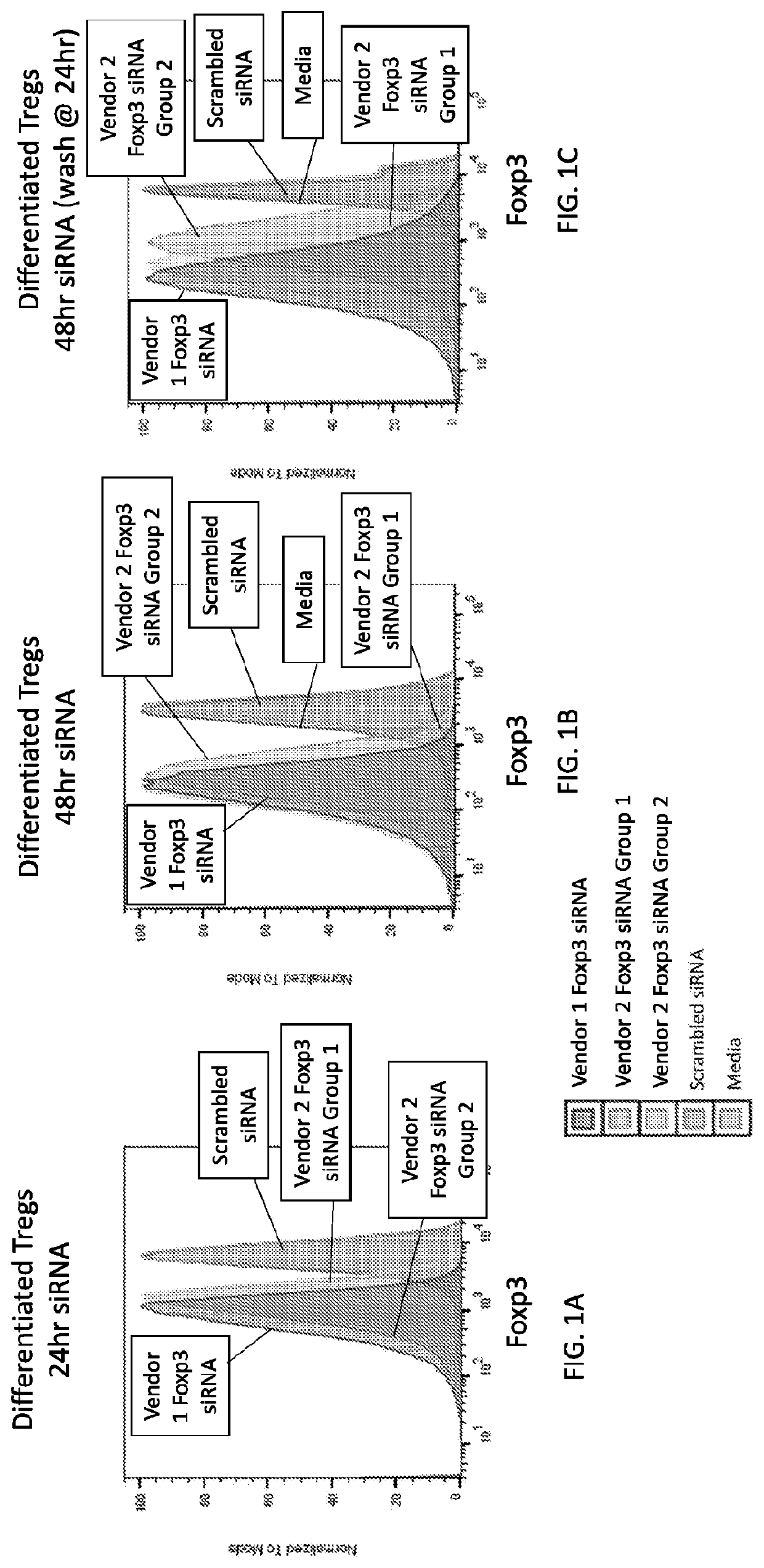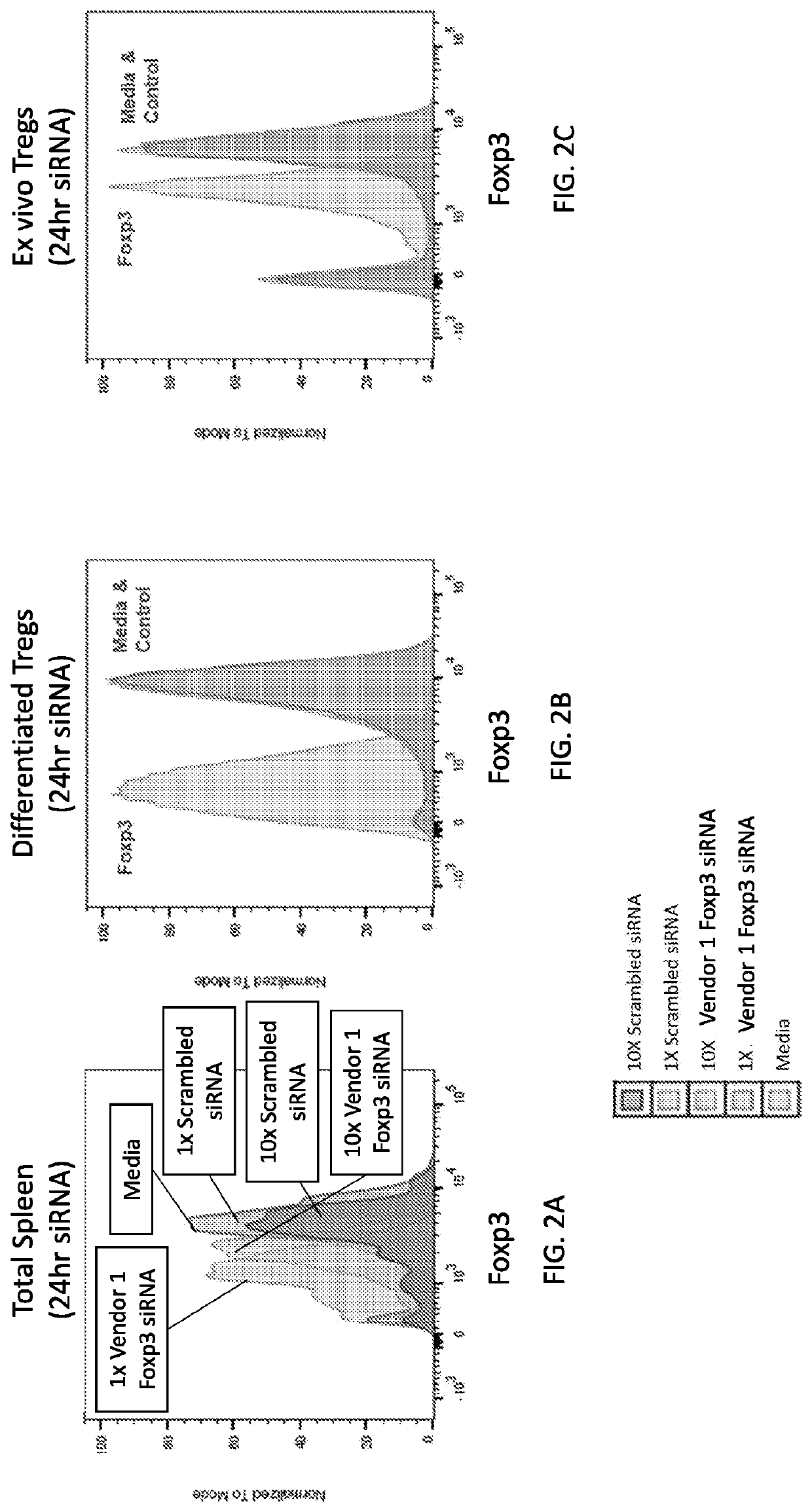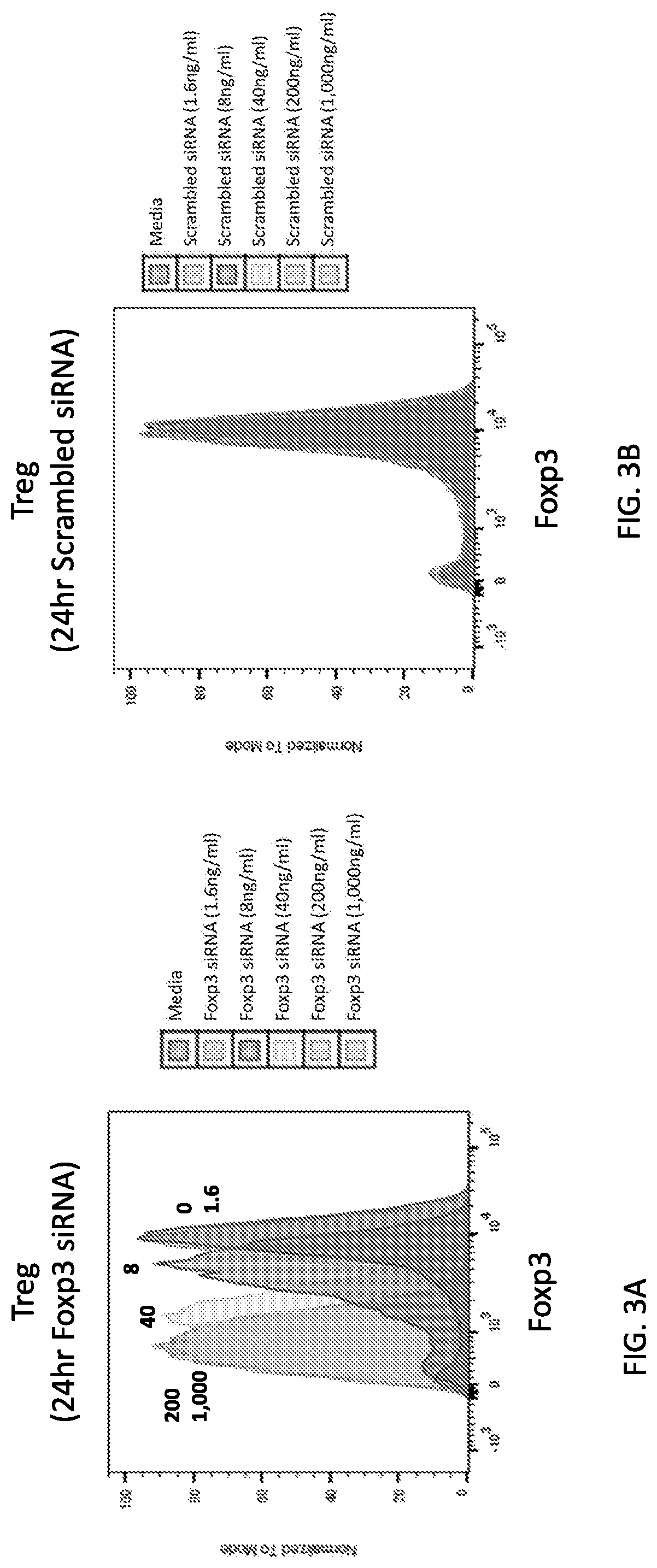Compositions and methods for delivery of RNA interference agents to immune cells
a technology of rna interference and compositions, applied in the direction of antibody medical ingredients, capsule delivery, dna/rna vaccination, etc., can solve the problems of reducing cancer immunosurveillance, difficult to control the immunomodulatory effects of such agents, and increasing susceptibility to infections and reducing cancer immunosurveillance,
- Summary
- Abstract
- Description
- Claims
- Application Information
AI Technical Summary
Benefits of technology
Problems solved by technology
Method used
Image
Examples
example 1
ation of Foxp3 Expression in In Vitro Differentiated Regulatory T Cells Using LNP-Encapsulated Foxp3 siRNA
[1485]In this example, Foxp3 siRNA constructs from three commercial sources were encapsulated in LNPs for targeting delivery to immune cells. The mouse Foxp3 sequences targeted by the siRNAs are shown in Genbank accession numbers NM_001199347.1, NM_001199348.1 and NM_054039.2. The tested siRNA preparations targeted various different regions of the Foxp3 gene, as shown below in Table 17:
TABLE 17Foxp3 siRNA ConstructsTargetedGeneLabelsiRNAregionScrambled siRNAsiRNA 0n / aVendor 1 Foxp3 siRNAsiRNA 1Exon 12Vendor 2 Foxp3 siRNA siRNA 2ORFGroup 1siRNA 3ORFsiRNA 4ORFsiRNA 5ORFVendor 2 Foxp3 siRNA siRNA 63′UTRGroup 2siRNA 7ORFsiRNA 83′UTRsiRNA 93′UTR
As indicated in Table 17, the Vendor 1 Foxp3 siRNA is a single siRNA construct, whereas the Vendor 2 Foxp3 siRNAs (Groups 1 and 2) are each pools of four siRNAs. Scrambled siRNA is the negative control siRNA.
[1486]The siRNA constructs were pur...
example 2
ation of Foxp3 Expression in Splenocytes and Ex Vivo Regulatory T Cells Using LNP-Encapsulated Foxp3 siRNA
[1489]Based on the results described in Example 1 showing downregulation of Foxp3 expression in in vitro differentiated mouse Treg cells by LNP-encapsulated Vendor 1 Foxp3 siRNA, the LNP formulation prepared as described in Example 1 was further tested on total mouse splenocytes and on mouse ex vivo Treg cells. Mouse splenocytes were plated in RPMI medium and immediately cultured for 24 hours with either 10 μg / mL or 1 μg / mL LNP-encapsulated siRNA (10× and 1×, respectively). Ex vivo Tregs were obtained by magnetically sorting cells from naïve C57BL / 6 mice using a mouse Treg isolation kit (StemCell Technologies). Ex vivo Tregs were then incubated with 1 μg / ml LNP-encapsulated siRNA for 24 h. The control was a scrambled siRNA.
[1490]The results are shown in FIGS. 2A-2C. For the splenocytes (FIG. 2A), inhibition of Foxp3 expression was observed in a dose-dependent manner, where Foxp3...
example 3
ndent Downregulation of Foxp3 Expression by LNP-Encapsulated Foxp3 siRNA
[1491]In this example, a dose titration of Foxp3 siRNA was performed on in vitro differentiated Tregs, testing serial five-fold dilutions starting at a top dose of 1,000 ng / mL. Differentiated Tregs were seeded at 1.0×106 cells / mL and cultured with the following doses of LNP-encapsulated siRNA: 1.6 ng / mL, 8 ng / mL, 40 ng / mL, 200 ng / mL or 1000 ng / ml. The control was a scrambled siRNA. LNP-encapsulated Vendor 1 Foxp3 siRNA was formulated as described in Example 1.
[1492]The results are shown in FIGS. 3A-3B. Foxp3 knock down was observed in a dose dependent manner during a 24 h incubation where Foxp3 siRNA had an effect of knock down as low as 5 ng / mL (FIG. 3A). No knock down was observed with scrambled siRNA for a 24 h incubation at equivalent doses (FIG. 3B).
PUM
| Property | Measurement | Unit |
|---|---|---|
| mol % | aaaaa | aaaaa |
| mol % | aaaaa | aaaaa |
| mol % | aaaaa | aaaaa |
Abstract
Description
Claims
Application Information
 Login to View More
Login to View More - R&D
- Intellectual Property
- Life Sciences
- Materials
- Tech Scout
- Unparalleled Data Quality
- Higher Quality Content
- 60% Fewer Hallucinations
Browse by: Latest US Patents, China's latest patents, Technical Efficacy Thesaurus, Application Domain, Technology Topic, Popular Technical Reports.
© 2025 PatSnap. All rights reserved.Legal|Privacy policy|Modern Slavery Act Transparency Statement|Sitemap|About US| Contact US: help@patsnap.com



